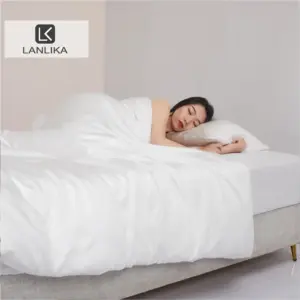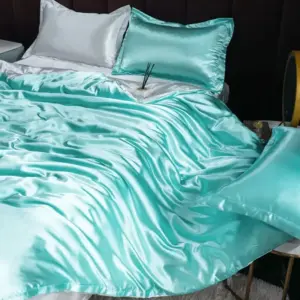Why You Should Always Use a Duvet Cover for Your Silk Duvet
Yes, you should absolutely use a duvet cover on a silk duvet. This isn’t just a suggestion—it’s an essential practice for protecting your luxury investment.
Silk duvets represent a significant purchase, often costing hundreds of dollars. Without proper protection, this investment can quickly lose its luster, comfort, and overall quality. Think about it this way: would you rather replace an entire silk duvet or simply purchase a new cover when needed?
Using a duvet cover provides three major benefits:
- Protection: Shields your silk duvet from daily wear, spills, body oils, and environmental damage
- Easier Maintenance: Simplifies cleaning by focusing on the cover rather than the delicate silk duvet
- Extended Lifespan: Significantly increases how long your silk duvet will maintain its quality and appearance
Many people worry that adding a cover might reduce the natural benefits of sleeping with amazing benefits mulberry silk sheets. The good news is that with the right cover material, you’ll still enjoy the temperature-regulating and skin-friendly properties silk is known for.
In this article, we’ll explore why duvet covers are essential for silk duvets, how to choose the right cover material, and best practices for maintaining both your cover and precious silk duvet.
For those wanting to start with proper protection right away, our silk bedding sets include perfectly matched components designed to work together.
How a Duvet Cover Protects Your Silk Investment
Silk is extraordinarily luxurious but also particularly vulnerable to damage from everyday exposure. Understanding these vulnerabilities helps explain why protection is so critical.
Your silk duvet faces numerous threats during regular use:
- Body oils and sweat: These natural secretions gradually break down silk fibers and can leave permanent stains
- Makeup and skincare products: Even traces of facial products can transfer to bedding and cause discoloration
- Accidental spills: Morning coffee, nighttime water, or other liquids can permanently damage silk
- Pet hair and dander: These can become embedded in the silk and are difficult to remove
- Friction damage: Direct contact with skin and sleepwear causes microscopic abrasions that lead to pilling and wear over time
Environmental factors also pose significant risks:
- Dust particles settle and work their way into the silk fibers
- Direct sunlight exposure leads to fading and weakening of the silk
- Humidity changes can affect silk’s integrity over time
A quality duvet cover creates an effective barrier against all these elements. Consider a scenario where your child accidentally spills juice on the bed—with a cover, you’re simply washing the cover rather than potentially ruining an expensive silk duvet.
Understanding the complete guide mulberry silk bed sheets provides additional context about why these luxury items deserve special care and protection.
For those seeking premium protective options that complement their silk duvets, our mulberry silk bedding sets provide coordinated protection with matching quality.
The Cleaning Challenge: Why Silk Duvets Are Difficult to Maintain
Silk duvets possess a complex internal structure that makes cleaning particularly challenging. Unlike regular bedding, silk duvets typically contain delicate silk floss filling that can easily become damaged when subjected to standard cleaning methods.
The risks of improper cleaning are substantial:
- Clumping: The silk filling can bunch together unevenly, creating uncomfortable lumps
- Shrinking: Improper washing techniques can cause the entire duvet to shrink
- Fiber damage: The delicate silk fibers can break down, reducing the duvet’s insulating properties
- Loss of natural properties: The qualities that make silk special—its breathability, moisture-wicking, and temperature regulation—can be diminished
Professional cleaning offers an alternative but comes with its own drawbacks. The cost typically ranges from $30-100 per cleaning, making it an expensive maintenance option. Additionally, some cleaning chemicals may be harsh on silk, and the inconvenience of transporting a bulky duvet to specialists means many people postpone necessary cleaning.
What makes cleaning particularly essential yet difficult is silk’s natural tendency to absorb moisture and oils. These properties that make mulberry silk special in terms of comfort also mean it readily absorbs sweat, body oils, and environmental moisture that must eventually be addressed for hygiene purposes.
Simplified Maintenance: How Duvet Covers Make Life Easier
Using a duvet cover dramatically simplifies the maintenance of your silk bedding. Instead of wrestling with cleaning a large, delicate silk duvet, you can simply remove the cover and wash it regularly.
Most duvet covers should be washed every 1-2 weeks, depending on your sleeping habits and environment. This regular cleaning schedule is much more practical than attempting to clean the silk duvet itself, which should be done infrequently to preserve its quality.
Different cover materials offer various laundering options:
- Cotton covers can typically handle warmer water and more frequent washing
- Silk covers require gentle cycles with cold water and mild detergents
- Synthetic blends often provide easy-care options with quick drying times
Seasonal changes become simpler with duvet covers as well. You can switch between lighter summer-weight covers and warmer winter options while keeping your silk duvet protected year-round. When not in use, covers take up minimal storage space compared to storing multiple duvets.
Spot cleaning becomes vastly more manageable with a duvet cover in place. Small spills or stains can be treated on the cover without risking damage to the silk duvet underneath. If a spill does penetrate to the duvet, you’ve still reduced its severity through the cover’s initial barrier.
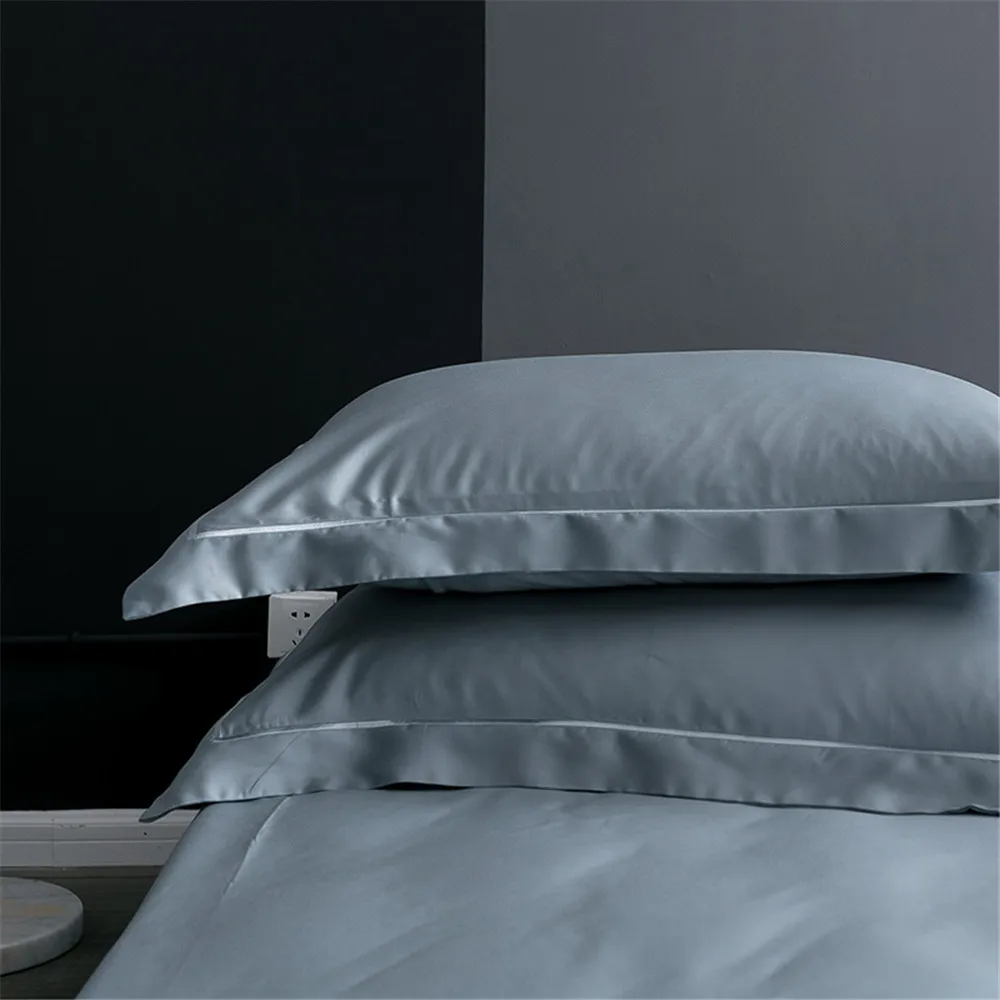
Our luxury silk bedding sets include duvet covers specifically designed to provide protection while complementing your existing silk bedding.
Extending the Lifespan: Keep Your Silk Duvet Beautiful for Years
The protection and simplified maintenance a duvet cover provides directly translates to a significantly extended lifespan for your silk duvet. This preservation of quality represents perhaps the most compelling reason to use a cover consistently.
With proper care including regular use of a duvet cover:
- A high-quality silk duvet can last 10-15 years or more
- Without a cover, the same duvet might last only 3-5 years before showing significant wear
Beyond simple longevity, a duvet cover helps preserve the qualities that make silk special:
- Breathability and temperature regulation: Keeping the silk clean and undamaged maintains its natural ability to regulate temperature
- Loft and fullness: Preventing compression and fiber damage helps the duvet maintain its plushness
- Visual appeal: Protection from UV exposure, stains, and wear preserves the silk’s natural luster and color
- Hypoallergenic properties: Keeping the silk clean and protected maintains its natural resistance to dust mites and allergens
Understanding the pros and cons of silk versus vegan silk can provide additional context for why preserving these natural properties matters so much for your sleep quality and comfort.
Choosing the Right Duvet Cover Material for Your Silk Duvet
Selecting the appropriate duvet cover material is crucial for maintaining the benefits of your silk duvet while providing adequate protection. Different materials offer various advantages depending on your priorities.
| Material | Breathability | Durability | Maintenance | Price Range | Compatibility with Silk |
|---|---|---|---|---|---|
| Silk | Excellent | Moderate | Delicate | High | Excellent |
| Cotton | Very Good | Good | Easy | Moderate | Good |
| Bamboo | Excellent | Good | Moderate | Moderate | Very Good |
| Linen | Excellent | Excellent | Moderate | High | Good |
| Synthetic | Fair to Good | Variable | Very Easy | Low | Fair |
Silk covers provide the most compatible option, maintaining the same breathability and skin benefits as your duvet. They create minimal friction, allowing the silk duvet to move naturally within the cover. However, they require similar delicate care as the duvet itself.
Cotton, particularly high-thread-count Egyptian or Pima cotton, offers excellent breathability while being easier to maintain. It’s more durable than silk covers and typically less expensive, making it a practical choice for many.
Bamboo-derived fabrics provide excellent moisture-wicking properties similar to silk but with easier care requirements and often at a lower price point. These covers work particularly well in humid environments.
When selecting a cover, consider how it might affect your sleep experience. A lower-quality synthetic cover could negate some of the temperature-regulating benefits of your silk duvet, while a complementary natural fabric will help maintain those properties.
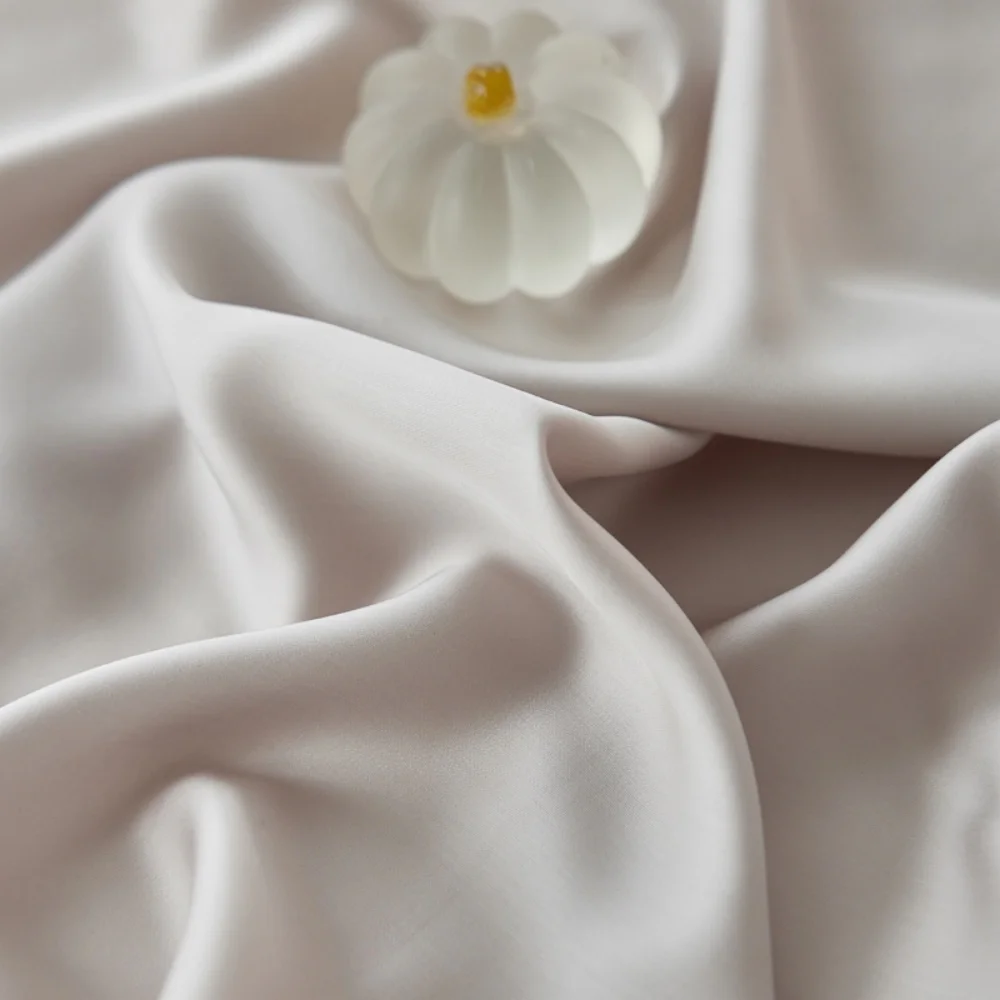
Explore our queen size silk bedding set options for covers perfectly sized to protect your duvet. For more detailed material comparisons, our guide on sleep silk cotton fabric comparison offers valuable insights.
Best Practices for Using Duvet Covers with Silk Duvets
Properly using a duvet cover with your silk duvet helps maximize protection while maintaining comfort. Follow these steps for the best experience:
The “Burrito Method” for Putting on a Duvet Cover:
- Turn your duvet cover inside out
- Lay the inside-out cover flat on the bed with the opening at the foot
- Place your silk duvet centered on top of the cover
- Starting from the head of the bed, roll both the duvet and cover together toward the foot (like a burrito)
- When you reach the opening, invert the cover opening around both sides of the rolled bundle
- Secure the closure (buttons, zipper, or ties)
- Unroll toward the head of the bed
- Shake gently to distribute the duvet evenly within the cover
When selecting duvet covers, consider these closure options:
- Buttons: Classic look but can be time-consuming to close
- Zippers: Quick and secure but may catch on delicate silk
- Ties: Gentle on fabric but may allow more shifting of the duvet inside
To prevent shifting inside the cover, look for duvet covers with internal ties or loops that correspond to corners on your silk duvet. This secures the duvet in place, preventing bunching or sliding.
Change your duvet cover seasonally to adjust to temperature changes. Lighter colors and weights work well for summer, while deeper colors and heavier materials offer coziness in winter. This seasonal rotation also extends the life of each cover.
The advantages of sleeping with mulberry silk are better maintained when your duvet is properly secured in a quality cover that complements its natural properties.
Caring for Your Silk Duvet When Using a Cover
Even with a protective cover, your silk duvet requires some maintenance to preserve its quality and performance over time.
Regular airing is essential:
- Every 3-6 months, remove the duvet from its cover
- Hang the duvet in a well-ventilated area away from direct sunlight
- Allow 2-3 hours of airing time to release trapped moisture and refresh the silk
- Gently shake or pat (never beat) to restore loft
Proper storage during off-seasons:
- Ensure the duvet is completely dry and clean before storing
- Use a breathable cotton storage bag rather than plastic
- Place in a cool, dry closet away from pressure or heavy items
- Add a natural cedar block to deter moths (avoid mothballs which can damage silk)
100% Silk Sheets, Green Silk Sheets, King Size Silk Bedding Set, Mulberry Silk Bedding Sets, Queen Size Silk Bedding Set
Price range: $1,246.21 through $1,615.22 Select options This product has multiple variants. The options may be chosen on the product pageFull Silk Bedding Set, King Size Silk Bedding Set
Price range: $120.99 through $190.49 Select options This product has multiple variants. The options may be chosen on the product pageGrey Silk Sheets, Silk Sheet and Pillowcase Set
Price range: $88.20 through $146.64 Select options This product has multiple variants. The options may be chosen on the product page100% Silk Sheets, King Size Silk Bedding Set, Mulberry Silk Bedding Sets, Queen Size Silk Bedding Set, White Silk Sheets
Price range: $1,000.79 through $1,351.42 Select options This product has multiple variants. The options may be chosen on the product pageKing Size Silk Bedding Set, Twin Silk Bedding Set
Price range: $120.99 through $190.49 Select options This product has multiple variants. The options may be chosen on the product pageLuxury Silk Bedding Sets, Mulberry Silk Bedding Sets, Silk Sheet and Pillowcase Set
Price range: $61.33 through $159.87 Select options This product has multiple variants. The options may be chosen on the product page
Despite using a cover, occasional maintenance of the duvet itself remains important. If minor spills penetrate the cover, spot clean the affected area on the duvet using a clean cloth slightly dampened with cold water. Blot gently rather than rubbing, which can damage silk fibers.
Professional cleaning may still be necessary every 3-5 years or if significant soiling occurs, but using a quality cover consistently will dramatically reduce this frequency.
Our king size silk bedding set collection includes covers designed with the proper dimensions to protect your investment while ensuring a perfect fit.
Is It Ever Appropriate Not to Use a Duvet Cover?
While we strongly recommend using a duvet cover consistently, there are a few limited scenarios where you might temporarily go without one:
When might you skip the cover temporarily?
For photography or display purposes, you might remove the cover briefly to showcase the silk duvet’s natural luster and appearance. However, this should be limited to short periods in clean environments away from food, drinks, or excessive handling.
Some people report wanting to experience the direct feel of silk against their skin for special occasions. If you choose to do this, ensure your body is clean and free from lotions or oils, and limit this practice to rare occasions.
What are the risks of even short-term use without a cover?
Even brief exposure increases the risk of accidental stains, oils transfer, and environmental damage. What seems like a small risk can result in permanent damage to an expensive item. Additionally, direct exposure to skin friction accelerates wear even if no visible damage occurs immediately.
For those with specific allergies or sensitivities, consistent use of a hypoallergenic cover provides an important barrier against dust mites and allergens that can accumulate even during short periods without protection.
Overall, while there may be brief exceptions, the general recommendation remains firm: a quality duvet cover should be used consistently to protect your silk duvet investment.
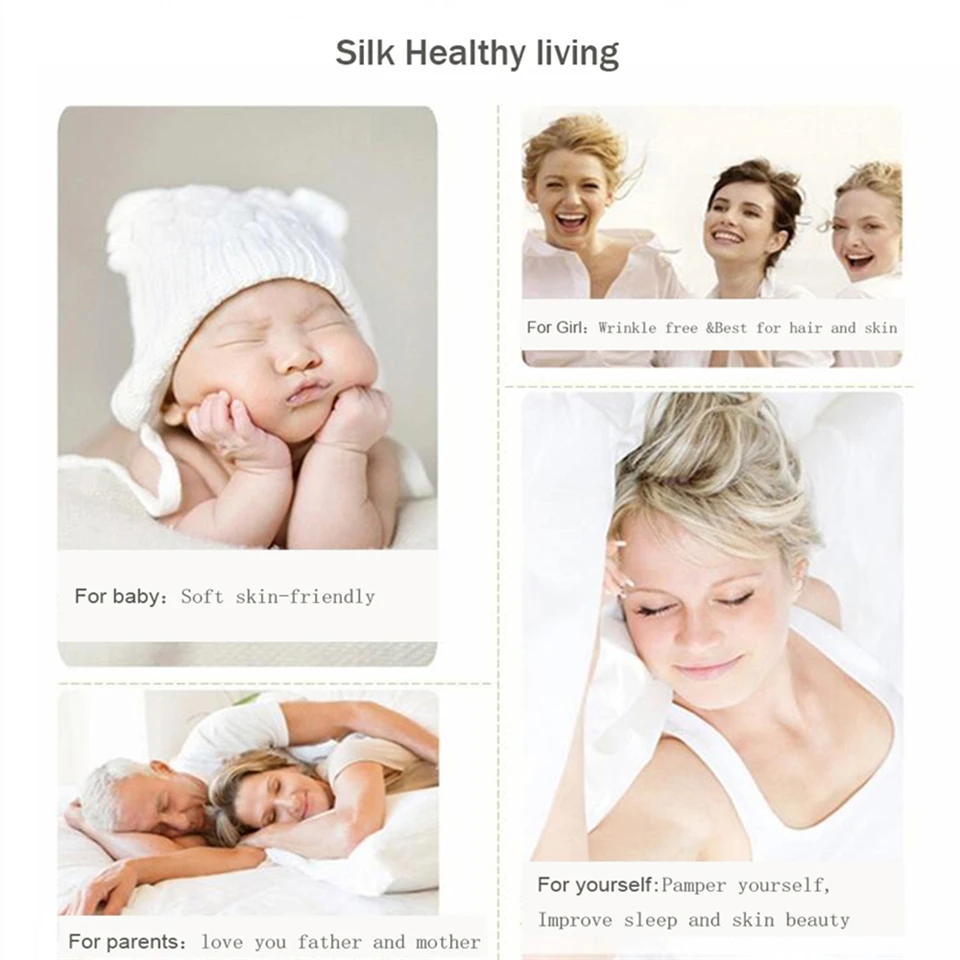
Understanding the mulberry silk bedding skin benefits can help you appreciate why consistent protection preserves these valuable properties.
Common Questions About Silk Duvets and Duvet Covers
Are silk duvet covers better than other materials for protecting silk duvets?
Silk duvet covers offer the most compatible protection as they create minimal friction with the silk duvet inside. However, high-quality cotton and bamboo covers also provide excellent protection while being easier to maintain. The best choice depends on your priorities regarding maintenance, cost, and sleep experience.
Will using a duvet cover reduce the benefits of my silk duvet?
A well-chosen duvet cover will preserve rather than diminish the benefits of your silk duvet. While an extremely thick or synthetic cover might slightly reduce breathability, appropriate natural fiber covers maintain temperature regulation while adding protection. The slight trade-off in direct silk contact is far outweighed by the preservation benefits.
How often should I wash my duvet cover versus my silk duvet?
Duvet covers should typically be washed every 1-2 weeks, depending on your sleeping habits. In contrast, silk duvets should rarely be washed—ideally only when absolutely necessary and according to manufacturer instructions, typically every few years or when soiled. This difference highlights the protective value of using a cover.
My duvet cover seems slightly larger than my silk duvet. Is this a problem?
A slightly oversized cover is actually preferable as it reduces stress on the silk duvet and allows proper loft. However, if the size difference is substantial (more than a few inches in each dimension), the duvet may shift too much inside the cover. Look for covers with corner ties to secure an appropriately sized duvet.
Should I use different duvet covers for different seasons?
Yes, seasonal rotation of duvet covers is recommended. Lighter fabrics and colors work well for warmer months, while heavier materials provide additional warmth in winter. This practice also extends the life of your covers through reduced continuous use.
For those with specific bed dimensions, our twin silk bedding set options provide properly sized protection for smaller beds.





